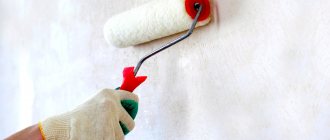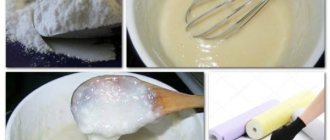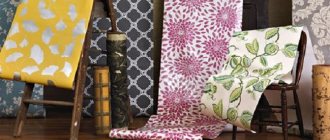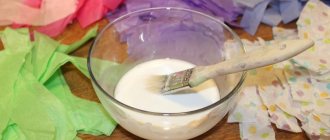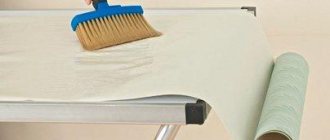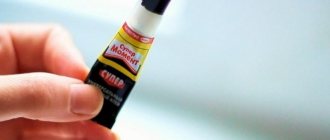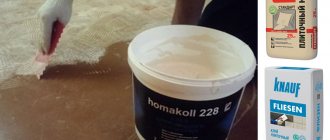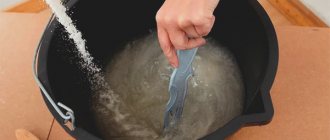Did you know that food starch can be used to make glue at home? The simple, affordable product is absolutely harmless and is widely used in everyday life.
Starch paste is used for gluing thin wallpaper and as a primer on walls. For coating paper and fabric insulation for window slits. For fixing album bindings and creative fakes. Homemade paste is made from starch or flour. A multifunctional way to make homemade paste is from potato starch.
Recipe for starch paste for wallpaper based on PVA
Starch paste is suitable for gluing wallpaper in light shades. It is almost transparent, and is also easily distributed over the surface of the canvas.
To prepare the glue, you need to do the following:
- Pass the starch through a sieve.
- Prepare the solution.
- Boil two liters of water.
- Pour the solution into boiling water.
- As soon as the mixture begins to thicken, turn off the stove.
- Leave the glue to sit and cool for two hours.
Starch is not able to dissolve in water. To dilute starch, you need to maintain the homogeneity of the solution. The mixture must be continuously shaken with a spoon.
How to brew starch without lumps? It is necessary to constantly stir the boiling mixture. To remove clots, you can pass the mixture through cheesecloth. You need to add PVA glue to the cooled mass at the rate of 20 grams of glue per liter of liquid. Adding PVA glue will help improve the tenacity of the mass.
Flour-based glue
Dissolve flour in cold water
How to make paste yourself? The classic recipe for flour paste at home is easy to follow. To prepare 1 liter of paste we need 200 g of flour.
Read also: Fluffy milk pancakes without yeast
To avoid unnecessary time and material costs, you should adhere to the following instructions:
- sift the flour through a fine sieve;
- thoroughly dissolve the flour in a small amount of cold water;
- 1 liter of water must be boiled;
- pour boiling water in a thin stream into the flour solution; put the mixture on low heat and bring to a boil with constant stirring;
- remove from heat, let cool slightly and remove the resulting film;
- strain the prepared mixture through a sieve.
The glue is ready to use. If the composition is very thick, simply dilute with water. Checking the consistency is very easy. The solution should drain from your fingers.
If, when you unclench, your fingers stick together slightly, then everything is done correctly.
It is better to use flour 1, not premium. A coarse mixture will provide better adhesion.
The glue should be prepared immediately before use; the composition does not last long. Within a day, its adhesive properties will greatly deteriorate.
The temperature of the applied paste should be about 30 - 400C. This composition can be used to prime walls; in this case, a hot solution is better. It is also suitable for gluing wallpaper.
Storage rules
The finished paste should be stored for no more than 10 days and only in the refrigerator. In this case, the container with the composition must be covered with a lid or plastic wrap. After long-term storage, a dense crust forms on the adhesive mixture, which must be removed before reusing the product. If mold appears on the adhesive composition, it means it cannot be used for its intended purpose.
It is best to prepare an exact portion of the paste, which will be enough for 1 day of planned work, so that you do not have to store the composition, because every day its quality characteristics decrease significantly.
An economical alternative to store-bought glue that is not inferior in performance is a paste made from flour at home. It will be useful for construction work, for joint creativity with a child, and for needlework. Ease of preparation, availability of ingredients, environmental friendliness, and ease of removing dried traces make the paste truly worthy of attention.
How to make paste for wallpaper and paper from flour
Now the market is overflowing with various adhesive products, but previously we cooked such a mass ourselves, and it was superior in quality to many modern analogues. How to make the paste that our grandmothers made? There are two proven recipes and several recommendations for choosing components.
What it is
Paste is a homemade gelatinous adhesive. The composition is used in needlework and, less often, in repairs (mainly for wallpapering). It contains no harmful additives, which cannot be said about industrial products. It is thanks to safety that the paste is still relevant. It replaces PVA well.
What are the advantages of making and using paste for modern people:
- This is an environmentally friendly product. All stages of preparation are traced. You can be sure that the composition is safe, unlike what the chemical industry offers.
- Paste replaces expensive glues, its cost is very low, in fact, it is equal to the cost of flour or starch.
- Easy to prepare, products are available at any time.
- Practical and easy to use composition.
- If you need to remove wallpaper glued to paste, it will not be difficult: just wet the walls, and the coating will come off without leaving a trace.
One of the disadvantages is the short shelf life. At room temperature it should be used within 24 hours. If you put it in the refrigerator, it will stay there for 2-3 days, but it will still spoil and you will have to throw it away.
To prepare the paste, a minimum of products are used: ordinary wheat / rye flour or starch. To make the composition as convenient as possible for use, you need to adhere to some principles in choosing components and tools:
- Flour is chosen of low quality. It is this product that gives the adhesive mass the necessary viscosity. Flour of the highest grade will not provide the glue with the required consistency.
- Before use, sift the flour through a sieve to remove lumps.
- In order for the mass to mix well, you will need a mixer or blender. But it is permissible to stir with a metal spoon - the main thing is that there are no lumps.
- The pan or basin is non-stick.
Cooking rules
To prepare the paste, it needs to be boiled. To do this, make a paste-like mixture of flour and water, place it on the stove and heat it over low heat until all the lumps disappear.
Rules for preparing the paste:
- The water is heated on the stove.
- Add flour in a thin stream and stir quickly to obtain a more or less homogeneous consistency.
- The approximate ratio of the bulk component and water is from 1:2 to 1:8.
- The process must be closely monitored so that the mixture does not burn.
- The composition should be cooked over minimal heat.
- During the cooking process, the paste is stirred with a wooden spatula.
- Ready-made hot glue is not used in this work. It needs to be cooled first.
Advice! To ensure that the glue does not burn, it is recommended to cook it in a water bath, but the process will take longer - from 15 to 20 minutes.
Wallpaper paste
When preparing homemade wallpaper glue, you need to follow the instructions to ensure the composition is of the proper quality.
Step-by-step recipe for making paste:
- Sift a glass of flour so that there are no lumps left.
- Add cold water in small portions, stirring continuously. You need to achieve the consistency of thick sour cream.
- Stir the solution thoroughly until all visible lumps dissolve.
- Now you should add water and bring the total volume of the mixture to 1 liter. If it turns out too thick, you can add a little more water, but this time hot.
- Add 0.5 tbsp to the mixture. PVA glue, mix everything thoroughly. This component will provide viscosity and quick setting.
- An alternative additive is wood glue. It will help when gluing painted walls.
- Place the pan with glue on low heat and cook until bubbles appear.
- Now you need to remove the dishes from the heat and stir all the lumps. It doesn’t hurt to filter the composition through gauze folded in several layers - it is important to be careful not to get burned.
- The paste is ready. It should be gelatinous and transparent. All that remains is to cool it and use it for its intended purpose as regular wallpaper glue.
- If a film forms on the surface, it must be removed.
Advice! Let the paste cool naturally, do not put it in the refrigerator.
Composition for creativity
For papier-mâché work, gluing crafts, creating appliques and other creative purposes, it is very easy to prepare good glue at home.
How to make such a composition:
- Place 1 cup of rye or wheat flour on the bottom of the pan.
- Pour in 1 glass of water and stir with a mixer.
- Gradually add 2 more glasses of water. The mass is stirred, you need to get rid of lumps.
- The pan is placed on the stove. The mixture is brought to a boil over low heat.
- Immediately after boiling, the container must be removed from the stove.
- Before use, you must wait until the glue has cooled completely.
This composition is stored in sealed glass containers for up to 2 days. Paper products fastened with such paste will hold firmly.
Starch paste
Instead of flour, potato starch is also used to create a paste. The starch-based composition has the same strength, and the method of its preparation is similar to the previous ones:
- In 10 tbsp. dilute water with 1 tbsp. starch and stir thoroughly.
- Add another 0.5 tbsp. water, stir the lumps.
- If it is too thick, dilute with a small amount of hot water.
- The mixture is simmered over low heat until it boils.
- Cooled starch paste can be used after 10 hours.
On a note
Making glue at home is a simple task, but you also need to apply it correctly. These tips will help you weld and use the paste as efficiently as possible:
- The paste is consumed within one day, no longer, as it sours quickly.
- The substance is not used for gluing thick and high-quality wallpaper. His expertise is medium-density paper wallpaper.
- Paste, especially from rye flour, is not recommended for overtly thin or light-colored wallpaper, as it can leave yellow spots that will show through.
- To make a paste that repels insects, add a little karbofos to it.
- In heat, the paste loses its characteristics. It should be stored in a cool place or at room temperature (+18-20˚ C).
- The composition must be prepared immediately before use. Maximum adhesive properties are revealed at a paste temperature of 40 degrees.
- Corn starch is often used instead of potato starch. The result is just as great.
Paste is a worthy analogue of modern adhesives. Its main advantages are safety for humans and low cost. Anyone can cook paste, this is another plus. Using homemade glue simplifies life in many ways: it saves money and protects against poisoning. The paste is good for both repairs and creativity.
Advantages and disadvantages
Before deciding whether to make wallpaper paste at home, it is important to consider all the pros and cons of such a decision, and then draw conclusions. Let's start with the positive points:
- High level of adhesion. Using homemade recipes, wallpaper can be easily fixed to any type of wall, even if it contains drying oil or paint particles that are difficult to remove.
- Safety and environmental friendliness. Starch, flour - all this is safe for health and the environment. The best option for a bedroom or nursery. In addition, wallpaper glue is hypoallergenic. It has no smell.
- Universal application. It doesn’t matter what wallpaper will be used in the decoration. A homemade paste will withstand them and ensure high-quality operation. Only very heavy canvases are best glued with special purchased glue.
- Easy to dismantle. Over time, the wallpaper needs to be replaced. The paste will help simplify the task of removing the canvas. To do this, moisten the surface with a damp cloth and wait.
- The structure of paper wallpaper will not be damaged, it will not get wet, so it will be very difficult to accidentally damage the trellises during installation.
- Invisible on the wall. The initial color of the paste is cloudy white. However, when the wallpaper dries, it becomes invisible. And if a particle of glue gets on the front part, it will not leave a mark.
If we talk about the disadvantages, then the main problem with homemade compositions is the fear of moisture. And PVA glue will not be able to make wallpaper paste as protected from moisture as the purchased version. Therefore, if the room has high humidity, these options will not be suitable. The second disadvantage is the shelf life. It does not exceed more than 24 hours. To increase it, additional manipulations described above are required.
How long does ready-made home glue last?
If you decide to make your own paste, you need to be prepared for the fact that it does not have a long shelf life. For this reason, it is not recommended to prepare it for future use. It is best to brew exactly as much glue as is needed for gluing wallpaper or making a product from papier-mâché, fabric, or paper.
The shelf life of adhesive made from flour or starch is limited to several days. For the mixture to which salt was added, it is even less - about a day or two.
In order to preserve the quality of the prepared product for as long as possible, you must follow the following rules:
- Store unused paste in a cool place at a temperature no higher than 18˚C (preferably in the refrigerator). In cold conditions it retains its properties longer, but thickens quickly. Before each subsequent use, it will have to be diluted with warm water.
- If you need to prepare glue in reserve, pour a small amount of the preservative component into it. Any alcohol-containing liquid available in the house, for example, alcohol or vodka, can act as a preservative.
- Do not store the glue container open. To prevent the product from drying out, it is recommended to cover it with a lid or plastic wrap.
If mold appears on the surface of the paste, it should be thrown away. The appearance of a slightly sour smell is not a reason to get rid of the adhesive mixture. It needs to be brought to a boil and allowed to cool completely.
I hope the material presented is enough to properly prepare homemade glue depending on its purpose. The following video will help you understand the above.
What is starch
Physically, it is a white powder, tasteless and odorless, soluble only in hot water. From a chemical point of view, starch is a polysaccharide. It consists of glucose without one molecule of water.
The formula of glucose is C6(H2O)6
Starch formula - C6(H2O)5
This feature determines starch as the main nutritional element for living beings. The cells of all living things need energy. The main supplier of energy is starch, found in plant foods. In the body, the substance is processed into glucose, which provides the body's cells with energy.
| From corn starch | High curing ability. Slightly cloudy. Cooked at high temperature. It may not spoil for a week or more. |
| From wheat starch (regular flour) | Medium hardening ability. Does not spoil for several days. A little cloudy. Widely used in bookbinding. It is not boiled, but poured in a thin stream into boiling water. Otherwise, after cooling, the paste will lag behind. |
| From potato starch | Transparent, clean. Low curing ability. It changes easily in air and sours quickly. Cooking does not require high temperatures. |
| From rye flour | It has an enviable strength when mixed with turpentine (resin). Resistant to dampness. It can be used for pasting stoves, gluing new wallpaper over old ones. |
Where can I use it?
The polysaccharide and derivatives based on it are used both in everyday life and in various areas of industrial production.
At home.
Until the middle of the last century, starch was the main substance from which wallpaper glue was made.
The starched collars and cuffs of men's shirts speak of the neatness of their owners. Wrinkle-resistant tablecloths, aprons, napkins are a characteristic of the housewife.
Foods prepared using plant ingredients always include this glucose derivative.
In industry.
- The production of paper and cardboard cannot exist without starch. In the production of corrugated cardboard in the middle of the last century, liquid glass was abandoned, replacing glass with a starch suspension.
- In the medical field, in the production of drugs, glucose polysaccharide is present in every tablet and capsule. All kinds of powders and solutions are also prepared using starch.
- Food manufacturers use polysaccharide as an independent product, the main filler. Glucose and ethanol are prepared from this carbohydrate.
- In the chemical industry, glucose polysaccharide is used as an indicator of chemical reactions. In these cases, the ability of starch to change color depending on the presence of certain substances in the solution is used.
